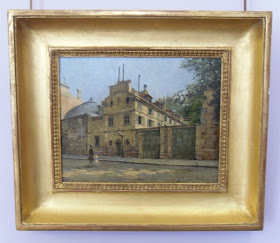'"Histoire de Paris
La Maison de Balzac
'"History of Paris
Balzac's House
Éve de Balzac by Jean Gigoud, about 1850. Eveline Rzewuski was born in either 1805 or 1806 and came from an aristocratic Polish family. About 1825 she married Venceslas Hanska and discovered Balzac by chance. In 1832 she wrote him an anonymous letter simply signed 'L'Étrangère', which was the beginning of what became a long amorous correspondence that lasted sixteen more years. In between, there were many brief encounters in different countries — such as Geneva in 1833, Vienna in 1835 — until her husband's death in 1841. It was then that Balzac sought to marry her, and although she was his traveling companion in the years between, she didn't marry him until March 1850, which was just five months before Balzac's death. She then began a long relationship with the painter of this picture. She lived in rue Fortunée, and died in 1882.
Hôtel de Balzac, rue Fortunée, by Paul-Victor-Joseph Dargaud (1880). Wanting to buy a property worthy of Madame Hanska, Balzac bought this for her in 1846. It had been known as 'Folie Beaujon', and Balzac himself compared it to barracks. He began an expensive process of restoring the dilapidated building. Rue Fortunée is now called rue Balzac, near L'Étoile, although this house was demolished in 1890.
Balzac's work desk.
The first page of La Vieille fille (1836), with Balzac's emendations.
A display case with several interesting items.
But it is the (unfortunately not very photogenic in its present location)cane which is the most interesting exhibit. It is a wonderful example of Balzac's dandyism, and of his pretentions in general. In 1832 Balzac asked his jeweller Le Cointe to make this. The cord and the turquoises come from an item of neckware worn by Madame Hanska as a young girl, and the handle is engraved with the Balzac d'Entragues arms: Balzac liked to think himself of aristocratic origin. Unsurprisingly, he became a target for satirists, an excellent example of which is Delphine de Girardin's La Canne de Monsieur de Balzac (1832), which speaks of the cane's magical power: invisibility.
A little out of focus, but this is the coffeepot (and the Musée Balzac at Saché has one too) that sustained Balzac through many hours of writing. For him, coffee had magic powers, although he was concerned that he took an excessive amount of it.
There are a number of sculptures of Balzac in the house. This one is by Patinatti (1837).
By David d'Angers (1844).
By Auguste Rodin (c. 1897).
The Tour Eiffel is visible from the garden, although obviously this did not exist in Balzac's day.
And at lunchtime (which is not when this shot was taken), on a fine day, city workers come here to have their lunch, to read, or merely to enjoy the calm atmosphere.
There is yet another bust of Balzac in the garden, this time by Carvellani.
My Honoré de Balzac posts:
–––––––––––––––––––––––––––––––––––
Honoré de Balzac in Passy
Honoré de Balzac in Saché
Balzac and statue, 8th arrondissement















No comments:
Post a Comment